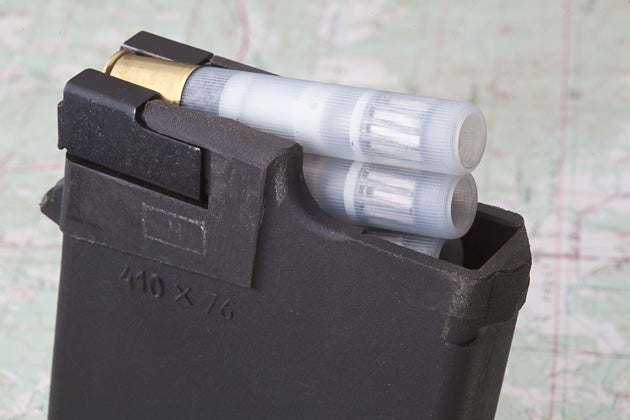Maximizing .410 Shotgun Performance for Hunting and Defense
Oleg Volk 10.21.13

.22 LR/.410 combination guns have been with us since before World War II. The idea was to provide a lightweight small game firearm with bullets for ground-based game and shot for birds and arboreal rodents.
Although 22 WMR and 22Hornet chamberings have been tried, most combination guns still use .22 LR mainly because of much lower ammunition cost. The light weight of the ammo is also helpful, with nearly 150 rounds to a pound. Likewise, complaints about the ineffectiveness of the .410 bore have been around for a while, and yet the chambering persists.
Despite .410 ammunition being more expensive than many of the 12ga loads now, it has three advantages for a survival gun: lighter weight, lower recoil and lesser report. A five to six pound .410 shotgun is easy on the shoulder but a lot less pleasant in 20ga or 12ga.
In larger bores, ammunition weight becomes a challenge for anyone traveling on foot: 12ga shells weigh from 44 to 56 grams, 20ga around 40 grams. For comparison, a .410 shotshell weighs in at only 22 grams, same as a 45ACP cartridge. Slug loads are even lighter, 11 to 12 grams, closer to the weight of a .223 cartridge than to the heavier 7.62×39. 12ga slugs in 2.75″ shells are about 9 to a pound, while the heaviest of the 3″ .410 Brenneke slugs are 38 to a pound.
Backpackers used to counting ounces gravitate towards lighter equipment, and guns are no exception. But light weight isn’t worth the savings if the firearm doesn’t do its job.
Most combination guns have fairly basic sights, limiting the aimed range of .22 LR barrel to 50 yards or less on small game. The long shot stack and light load of the .410 shotshells limits them to about 15 yards on small game.
For defense, the main options are buckshot and slug loads. Nominal 000 Buck doesn’t pattern well, as mentioned in the Circuit Judge article. Typical slugs are hollow 85 grain lead thimbles that fragment excessively on impact, giving only about 7″ of penetration in gelatin. The one apparent standout in the .410 lineup is the 114 grain Brenneke load. It has the same velocity and energy at the muzzle as a 110-grain .357 Mag fired from a carbine, but with the advantage of 30% greater frontal area. According to hunters, it is adequate for deer out to 40 yards or so. I decided to test that assertion.

Brenneke slugs work with rifles and smooth bores, but rifling would make shot loads ineffective and defeat the point of having a universal survival gun. So my test gun is a smoothbore Saiga .410 picked because its optional 10 round magazines make it also useful for self-defense. For my tests, I fired four shot series using the smaller 4-shot box magazine. Fixed 4 power scope reduced the aiming variations.

The .410 Saiga is gas operated and has all the felt recoil of a .22 rifle. The trigger is fairly decent, so if any platform would show the slugs to advantage, this would be it. I ended up shooting about 50 slugs in two separate range trips. I had zero malfunctions. Shot at 55 yards, groups of five would cover 3.5″ and show slight keyholing as the stubby projectiles became transonic. My next test was at 35 yards, that being the maximum range recommended by manufacturer.

Shotgun slugs are designed to deform easily for safe passage through the full chokes typical of older single shot .410s. The cylinder bore of the Saiga emitted the .410 caliber lead cylinders untouched, as evident from the textured edges of the holes in the target.

This level of accuracy is definitely acceptable for deer or hostile hominid. The solid, slightly streamlined design of the Brenneke definitely squeezes the most out of the marginal .410 slug terminal performance. At 35 yards, the velocity is down to about 1310fps. At 55 yards, the slug travels at just over 1140fps, which is still enough for over 17 inches of penetration in gelatin with a slight controlled expansion. The .45 caliber wound channel isn’t exceptional by deer rifle standards, but it’s plenty to bring down dinner. The reserves of penetrating ability allow the slug to defeat most bones.
In sum, .410 combination guns have their place in the survival line-up. Their limitations of range must be respected, but they do have enough power up close to take down deer-sized game or a cougar-sized threat — provided good ammunition is used and shots are well placed. Because the same sights are used for both .22 and .410 barrels, the shooter should decided which of them is the most important and use Kentucky windage for the other. That consideration is the most realistic limitation of using combination guns with slugs. A lightweight .22 handgun with a separate .410 shotgun is a viable alternative and provides the benefit of two sighting systems at little additional weight.